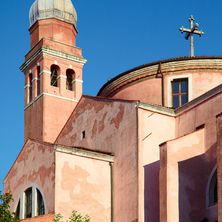

The Church of San Giacomo dell'Orio has a puzzling name. It is still unclear what "dell'Orio" actually means. Some associate it with "lauro," the Italian word for laurel, for there may have been laurel trees in the vicinity. Some think it comes from the Italian "dal Rio," which means of the river. Others suggest it derives from the word "luprio," the name for a swamp that was once present on the territory. One thing is certain however: the church is dedicated to St. James the Apostle, one of the first apostles to join Christ and the first apostle to be martyred.
James was also one of the three Apostles to have witnessed Jesus's transfiguration. This was a unique miracle, for it was the only one that had been performed on Jesus himself. Jesus ascended a mountain and suddenly began to shine with bright rays of light. Then the prophets Moses and Elijah appeared by his side and he spoke with them. Finally, a voice from the sky was heard saying "Son," which was obviously interpreted to have been that of God the Father.
James then preached the Gospels in Iberia, where the Virgin Mary appeared to him. When he returned to Judea, he was beheaded by King Herod Agrippa I himself. His headless body was then taken up by his disciples and transported back to Iberia, where it eventually reached Compostela, the city in northwestern Spain that hosts an annual pilgrimage in his name. James, whose relics still lie in the Santiago de Compostela Cathedral, later miraculously appeared before the Christian army as they were driving the Muslim Moors out of Spain. He is thus often called James the Moor-slayer and is the patron saint of Spain.
The original Church of San Giacomo dell'Orio was constructed in the 9th century. It was then rebuilt in the 13th with the construction of the bell tower and the addition of some Byzantine pieces, such as the green marble columns, brought back from the IV Crusade. The final renovation took place in 1532. The interior presents an amalgamation of architectural styles. The three-nave Latin-cross layout dates back to the 13th century Romanesque period, the "keel" roof is of Gothic imprint, while the ornamentations are reminiscent of Lombardian influence. Contrary to its unappealing exterior, inside the church we can find several admirable works of art. The St. James altarpiece, painted by Lorenzo Lotto in 1546, is a fine example of the Venetian "sacred conversation" genre, in which saints, as well as important Venetian patrons, converse with the mother of God. Also noteworthy are the Deposition from the Cross and the Ascent to Calvary by Jacopo Palma the Younger, whose less striking works are also exhibited in the Old Sacristy. In the New Sacristy, located by the presbytery, we can find three masterpieces by Paolo Veronese: the Allegory of Faith, at the center of the ceiling; the Four Doctors of the Church, at the sides; and altarpiece dedicated to St. Lawrence, St. Prosper and St. Julian.
The Campo San Giacomo dell'Orio surrounding the church is a perfect place to take a break after walking around and sightseeing. Its colors are especially captivating during the autumn when the leaves turn orange and yellow and are bestrewed on the ground by crisp breezes and winds. In the winter, carnival costumes drift through the spacious fog, while in the summer, the square hosts numerous concerts, contests, markets and barbeques. And the most popular dish during the cookouts, as would be expected, is the scallop, which in Italian is called either "capasanta" or "conchiglia di San Giacomo", that is, the shell of St. James.